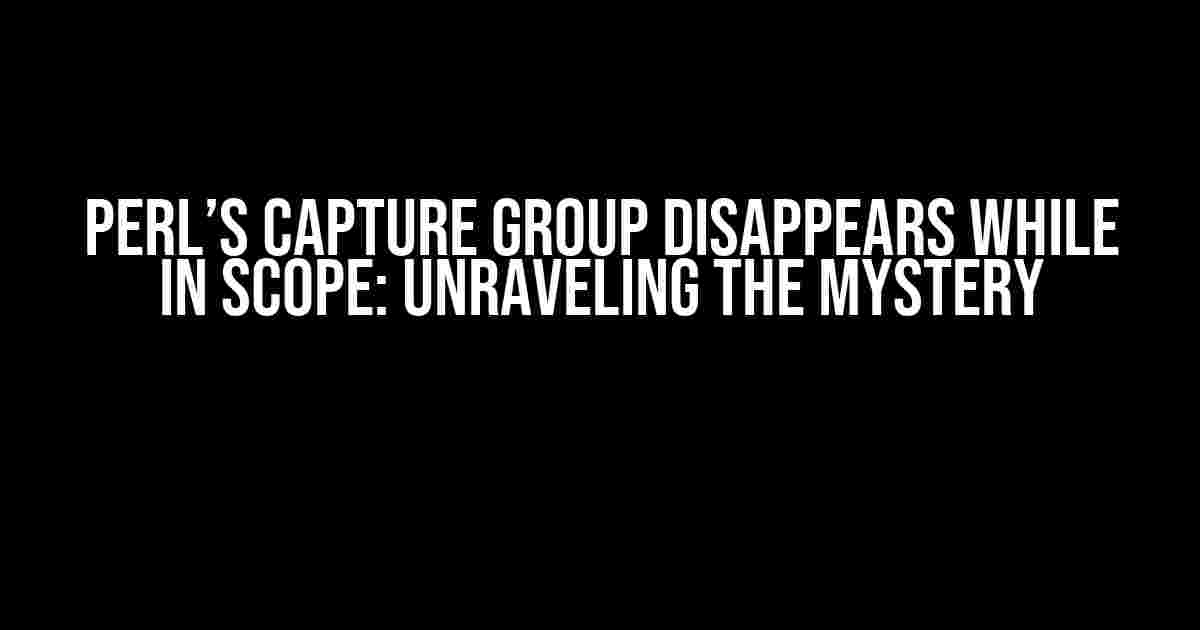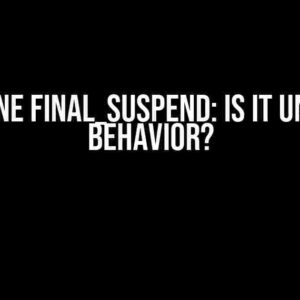Have you ever encountered a scenario where Perl’s capture group seemed to vanish into thin air, leaving you bewildered and frustrated? You’re not alone! This phenomenon has puzzled many a Perl programmer, and today, we’ll delve into the world of regular expressions to uncover the truth behind Perl’s capture group disappearing act.
What is a Capture Group?
A capture group, also known as a capturing group or a group, is a way to group a pattern in a regular expression. It’s a crucial concept in Perl, allowing you to extract specific parts of a string and reuse them later. Capture groups are defined using parentheses `()` and are numbered starting from 1.
my $string = "hello, world!";
my ($greeting, $place) = $string =~ /(.+), (.+)/;
print "Greeting: $greeting, Place: $place"; # Output: Greeting: hello, Place: world!What Causes the Capture Group to Disappear?
So, what’s behind this enigmatic disappearance? The answer lies in how Perl handles scope and regular expression matching. When a regular expression is executed, Perl creates a temporary scope for the match. Within this scope, the capture groups are stored in the `@-` and `@+` arrays.
However, as soon as the regular expression engine exits the scope, the capture groups are destroyed, leaving you with an empty `@-` and `@+` arrays. This is where the magic happens – or rather, where the magic disappears!
Scope and Regular Expression Matching
To understand the disappearing capture group, let’s examine how Perl handles scope and regular expression matching:
- Scope creation: When a regular expression is executed, Perl creates a new scope for the match.
- Matching and capturing: The regular expression engine matches the pattern and stores the capture groups in the `@-` and `@+` arrays within the scope.
- Scope exit: When the regular expression engine exits the scope, the capture groups are destroyed, and the `@-` and `@+` arrays are reset.
This process is crucial to understanding why capture groups seem to disappear. The key is to realize that capture groups are tied to the scope of the regular expression match.
Solutions to the Disappearing Capture Group Problem
Now that we’ve uncovered the mystery behind the disappearing capture group, it’s time to explore some solutions to this problem:
1. Using the `scalar` keyword
One way to preserve the capture group is by using the `scalar` keyword, which forces the expression to be evaluated in scalar context:
my $string = "hello, world!";
my $greeting = scalar $string =~ /(hello)/;
print "Greeting: $greeting"; # Output: Greeting: hello2. Assigning to an array
Another approach is to assign the capture groups to an array:
my $string = "hello, world!";
my @capture_groups = $string =~ /(hello), (.+)/;
print "Greeting: $capture_groups[0], Place: $capture_groups[1]"; # Output: Greeting: hello, Place: world!3. Using a block and lexical variables
You can also use a block and declare lexical variables to keep the capture groups alive:
my $string = "hello, world!";
{
my ($greeting, $place) = $string =~ /(hello), (.+)/;
print "Greeting: $greeting, Place: $place"; # Output: Greeting: hello, Place: world!
}
print "Outside block: $greeting"; # Output: UndefinedBest Practices for Working with Capture Groups
To avoid the disappearing capture group problem, follow these best practices:
- Use the `scalar` keyword: When working with scalar values, use the `scalar` keyword to ensure the expression is evaluated in scalar context.
- Assign to an array: When working with multiple capture groups, assign them to an array to preserve their values.
- Use a block and lexical variables: When working with capture groups, use a block and declare lexical variables to keep them alive.
- Avoid using `@-` and `@+` arrays: Instead, use named capture groups or assign the capture groups to an array to avoid relying on the `@-` and `@+` arrays.
| Scenario | Solution |
|---|---|
| Scalar context | Use the `scalar` keyword |
| Multiple capture groups | Assign to an array |
| Preserve capture groups | Use a block and lexical variables |
Conclusion
Perl’s capture group disappearing act is a common phenomenon that can be puzzling, but by understanding the underlying mechanics of scope and regular expression matching, you can master the art of working with capture groups. By following the best practices outlined above, you’ll be well-equipped to handle even the most complex regular expressions and ensure that your capture groups remain intact.
Remember, the key to success lies in understanding the scope of the regular expression match and using the correct techniques to preserve the capture groups. With practice and patience, you’ll become a Perl regular expression wizard, effortlessly conjuring capture groups that never disappear!
So, the next time you encounter a disappearing capture group, don’t panic – simply recall the wisdom imparted in this article, and you’ll be well on your way to taming the wild world of Perl regular expressions.
Here are 5 questions and answers about “Perl’s capture group disappears while in scope” with a creative voice and tone:
Frequently Asked Question
Get the answers to your most pressing questions about Perl’s capture group!
Why do Perl’s capture groups disappear while in scope?
This happens because Perl’s capture groups are stored in a scalar variable, and when the variable goes out of scope, the capture group disappears. It’s like a magic trick, but not in a good way!
How can I prevent Perl’s capture groups from disappearing?
One way to do this is to assign the capture group to a variable or a data structure, like an array or hash, as soon as you get it. This way, you can keep the capture group alive and kicking, even when the original scalar variable goes out of scope!
What happens if I try to access a disappeared capture group?
Well, let’s just say it’s not pretty! If you try to access a capture group that’s no longer in scope, Perl will raise a warning or error, depending on your settings. It’s like trying to grab a fistful of air – you’ll just end up with nothing!
Can I use Perl’s capture groups with other languages?
Unfortunately, Perl’s capture groups are a Perl-only thing. If you try to use them with other languages, like Python or Java, you’ll just get a bunch of confused looks and error messages. But hey, that’s what makes Perl so special, right?
Are Perl’s capture groups worth the trouble?
Absolutely! Perl’s capture groups are an incredibly powerful tool for text processing and pattern matching. Yeah, they can be a bit finicky, but with a little practice and patience, you’ll be capturing groups like a pro! And trust us, the benefits far outweigh the trouble.



